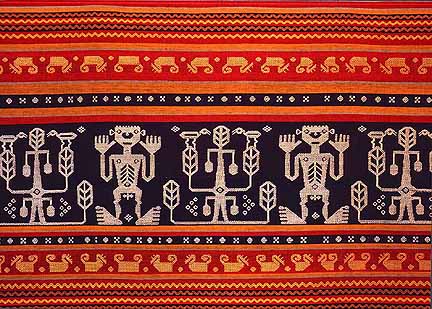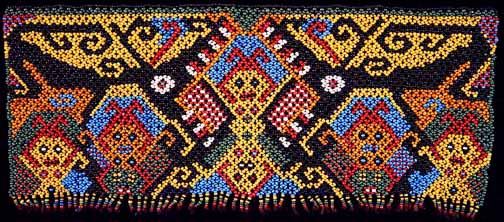Home | Vol 18 Table of Contents | Previous Issues | Contact Us: 07 55278753 / 0405463663 | Email: judybyronbay@yahoo.com
Batik of Bali.
The Ikat
The Batik of Bali expresses the artistic excellence of the Balinese people. Their beautiful designs, inspired by religious mythologies to everyday encounters, spread throughout the world. Originally stimulated by Javanese motifs, dominated by wayang and other mythological characters. Contemporary batik artists have also experienced artistic development that parallels that of paintings. Modern batik artists express themselves through various subjects, from objects of nature such as birds or fish to daily activities such as cremation procession or tourist attractions as well as religious and mythological stories, accompanied by modern interpretation.
The Ikat and Double Ikat are two amazing techniques that the Balinese
have perfected. A piece of Ikat cloth is woven in such a way that the
ink is 'tied' (which is what 'ikat' literally translates to) in one
of the two threads. A Double Ikat recursively repeats this technique;
both threads contain ink. The ink will bleed to its neighbouring area,
and the result is a piece of cloth with distinctive, s ubtle
patterns.
ubtle
patterns.
INDONESIAN TRADITIONAL TEXTILE WEAVING
Ikat textiles of Indonesia have the distinction of being among the most highly priced textiles in the world. Revered by the generation of Royal Families, treasured in the finest museums of the world, their beauty lies enmeshed in their rich visual texture and precision bound technique.
Right, Ceremonial panel from Sumba.
The word of Ikat means tie or bind. The pattern that is required on the cloth is knotted and bound onto the warp yarn and the thread is dyed before weaving. Ikat cloth is made in many scattered regions of the Indonesian Archipelago such as from Batak & Lampung (Sumatra), Dayaks (Kalimantan), Tenganan (Bali), Denggala & Rongkong (Sulawesi) and the outstanding work comes from Lesser Sunda Islands (Lombok, Sumba, Timor, Flores, Sawu, Rote & Alor) where its ancient art form thrives most strongly.
The three basic forms of Ikat are: - Single Ikat-where either warp or weft yarns are tied and dyed. Combined Ikat: -- where warp and weft Ikat may co-exist in different parts of the fabric.Double Ikat: -- where both warp and weft threads are tied with such precision that when woven, threads from both axis mesh exactly at certain points to form a complete motif or pattern.
 left,
Kalimantan beadwork.
left,
Kalimantan beadwork.
Ikat garments are still in daily use on those areas and there is an incredible diversity of colours and patterns. The spectacular ikat of Sumba and the intricate patterned work of Flores are the best known, but Timor and Lombok and small islands like Rote, Sawu, Lembata and Alor all have their own varied and high quality traditions.
Research by Radha Koch.